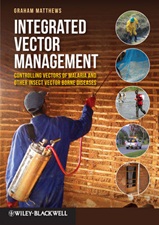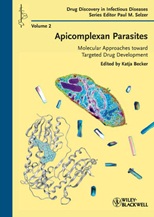1. Integrated Vector Management: Controlling Vectors of Malaria and Other Insect Vector Borne Diseases
Graham Matthews
ISBN: 978-0-470-65966-3
248 pages
October 2011, Wiley-Blackwell

Description
Diseases transmitted by insects continue to have a major impact on human populations. Malaria, dengue, onchocerciasis, sleeping sickness and leishmaniasis all adversely affect man. Malaria is one of the most important causes of child mortality and reduces economic development in many countries, with agricultural productivity often greatly reduced, as many vectors are active in the wet season favourable for crop production. Vector control is crucial to reduce the extent to which drugs are needed to treat the diseases, as the parasite can become resistant, or the drugs are often too expensive for those living in rural areas and urban slums most affected by these diseases.
Chemical control of vectors is often the only method that can reduce vector populations in a disease epidemic, but with vectors developing resistance to insecticides, there is increasing awareness that a single control method is often insufficient and also that chemical control must be integrated where possible with other control measures.
In Integrated Vector Management, Graham Matthews covers the main chemical methods of vector control, including the use of indoor residual spraying, space treatments, the use of treated bed nets and larviciding, but also stresses the importance of drainage schemes and improvement of houses to prevent access of indoor vectors, techniques that have largely been responsible for reducing the risk of vector borne diseases in Europe and the USA. This book combines practical information from successful vector control programmes, including early use of DDT, and recent research into a vital resource for all those now involved in combating insect vector borne diseases.
Integrated Vector Management is an essential tool, not only for medical entomologists and those directly involved in government health departments, but also for all those who provide the skills and management needed to operate successful area-wide vector management programmes. Libraries in all universities and research establishments world-wide, where biological sciences, medicine and agriculture are studied and taught should have multiple copies of this important book.
Table of Contents
Preface
Acknowledgements
1 Introduction
Insect vectors
Distribution of vectors
Mosquitoes
Anopheles spp.
Aedes spp.
Culex spp.
Flies
Simulium spp.
Glossina spp. tsetse flies
Phlebotomine sand flies
Musca domestica and other synanthropic spp.
Other vectors
Triatomine bugs
Chemical control
Hazard and toxicity
Toxicity
Insecticides
WHO recommendations
Formulations
Packaging and storage
Waste disposal
Conclusion
References
2 Indoor Residual Spraying
Equipment for indoor residual spraying
Spray volume
Insecticides
Operator exposure
Resident exposure
Implementation of indoor residual spraying
Village intervention teams
Planning programmes
Insecticides
Equipment required
Storage
Training
Monitoring
Environmental assessment
Evaluation
Economics
Conclusion
References
3 Space Treatment
Requirements for space treatments
Equipment for space treatments
Portable equipment
Mist treatments
Vehicle mounted equipment
Aerial application
Insecticides
Planning
Assessment of space sprays
Monitoring
Conclusion
References
4 Bed Nets and Treated Clothing
Material
Mesh size
Shape
Insecticide
Insecticide impregnation
Impact of washing nets
Distribution of nets
Trial data
Operational use
Treated clothing
Impregnated sheeting
Conclusion
References
5 Larviciding
Larvicide application
Mosquito control
Oils
Insecticides
Application of mosquito larvicides
Knapsack spraying
Motorised equipment
Aerial application for mosquito control
Application of aerial sprays
Application of granules
Ground application
Aerial application
Monitoring
Black flies
Insecticides
Aerial application of larvicides for black fly control
Boat application
Applications in small streams
Monitoring
Conclusion
References
6 Integrated Vector Management
Cultural controls
House design
Drainage and water management schemes
Personal protection
Impregnated clothing
Insecticide treated bed nets
Repellents
Barrier treatments
Implementation of IVM
An example of IVM at Copper mines in Zambia
Costs
Development of new technology
Conclusion
References
7 Other Insects – Flies, Cockroaches and Bed Bugs
Flies
Refuse dumps
Space treatments
Mist treatments
Cockroaches
Traps
Sprays
Baits
Bed bugs
Conclusion
References
8 Looking Ahead
New insecticides?
Can insecticides with new modes of action be developed?
Insecticide resistance
Bio-pesticides
Spray technology
Electrostatic spraying?
Different sprayers?
Different nozzles?
Using a paint
Innovative application technique
Genetically modified mosquitoes
Attractants
Urbanisation
Economics
Conclusion
References
Appendix A: Calibration
Appendix B: Conversion Tables
Index
Author Information
Graham Matthews is Emeritus Professor of Pest Management at Imperial College, London, UK and, since 1972, he has advised the World Health Organization on the equipment used for vector control. Over the last decade he has also been Technical Director of the NGO, Yaounde Initiative Foundation and has been directly involved in vector control in Cameroon.
2. Apicomplexan Parasites: Molecular Approaches toward Targeted Drug Development
Katja Becker (Editor), Paul M. Selzer (Series Editor)
ISBN: 978-3-527-32731-7
550 pages
February 2011, Wiley-Blackwell

Description
This handbook is the first dealing with the discovery of drugs directed against apicomplexan parasites. Amongst others, this group of endoparasites includes the causative agents of Malaria, Toxoplasmosis, and Babesiosis, the latter occurring mainly in animals. Written by renowned scientific experts from academia and industry, the book focuses on currentdrug development approaches for all apicomplexan diseases making it appealing to a large audience, ranging from research labs in academia to the human and veterinarian pharmaceutical industry. This work is the second volume of the new book series 'Drug Discovery in Infectious Diseases', edited by Prof. Dr Paul M. Selzer.
Table of Contents
SCREENING, BIOINFORMATICS, CHEMOINFORMATICS, AND DRUG DESIGN
Drug Discovery Approaches towards Anti-Parasitic Agents
(Andreas Rohwer, Richard J. Marhöfer, Conor R. Caffrey and Paul M. Selzer)
New Bioinformatic Strategies against Apicomplexan Parasites
(Thomas Dandekar and Ke Xiao)
Sorting Potential Therapeutic Targets in Apicomplexa
(Jan A. Hiss and Gisbert Schneider)
Alternatives to Drug Development in Apicomplexa
(Prof. Dr. Theo P.M. Schetters)
METABOLIC PATHWAYS AND PROCESSES ADDRESSED BY CURRENT DRUG DISCOVERY APPROACHES
The Energy Metabolism as an Antimalarial Drug Target
(Esther Jortzik and Katja Becker)
Polyamines in Apicomplexan Parasites
(Ingrid B. Müller, Robin Das Gupta, Kai Lüersen, Carsten Wrenger and Rolf D. Walter)
The Reducing Milieu of Parasitized Cells as a Target of Antimalarial Agents. Methylene Blue as an Ethical Drug
(Peter Meissner, Heike Adler, Karin Fritz-Wolf and R. Heiner Schirmer)
Lipids as Drug Targets for Malaria Therapy
(Henri J. Vial, Diana Penarete, Sharon Wein, Sergio Caldarelli, Laurent Fraisse and Suzanne Peyrottes)
Targeting Apicoplast Pathways in Plasmodium
(Snober S. Mir, Subir Biswas and Saman Habib)
Lipoic Acid Acquisition and Glutathione Biosynthesis in Apicomplexan Parasites
(Janet Storm, Eva-Maria Patzewitz and Sylke Müller)
Antimalarial Drugs and Molecules Inhibiting Hemozoin formation
(Uday Bandyopadhyay and Sumanta Dey)
Exploiting the Vitamin Metabolism of Apicomplexa as Drug Targets
(Carsten Wrenger and Ingrid B. Müller)
Vitamin Biosynthetic Pathways, the PLP Synthase Complex, and the Potential for Drugging Protein-Protein Interaction
(Ivo Tews and Irmgard Sinning)
Targeting Prokaryotic Enzymes in the Eukaryotic Pathogen Cryptosporidium
(Suresh Kumar Gorla, Corey Johnson, Jihan Khan, Xin Sun, Lisa Sharling,
Boris Striepen and Lizbeth Hedstrom)
DRUG TARGETS IN APICOMPLEXAN PARASITES
Novel Apicomplexan Phosphatases and Immunophilins
as Domain-Specific Drug Targets
(Sailen Barik)
Dehydrogenases and enzymes of the mitochondrial electron transport chain as antiapicomplexan drug targets
(Kathleen Zocher, Stefan Rahlfs and Katja Becker)
Calcium-dependent protein kinases as drug targets in apicomplexan parasites
(Dominik Kugelstadt, Bianca Derrer, and Barbara Kappes)
Protein Acylation:
New Potential Targets for Intervention against Apicomplexa
(Joana M. Santos, Christian Hedberg and Dominique Soldati-Favre)
Drugs and Drug Targets in Neospora Caninum and Related Apicomplexans
(Joachim Müller, Norbert Müller and Andrew Hemphill)
COMPOUNDS
Subversive Substrates of Glutathione Reductases from P. Falciparum-infected Red Blood Cells as Antimalarial Agents
(Elisabeth Davioud-Charvet and Don Antoine Lanfranchi)
Ferroquine: a Concealed Weapon (Christophe Biota, Bruno Pradinesb and Daniel Divec)
Current Aspects of Endoperoxides in Antiparasitic Chemotherapy
(Denis Matovu Kasozi, Stefan Rahlfs and Katja Becker)
Plasmodium Hsp90 as an Antimalarial Target
(G. Sridhar Prasad and Sailen Barik)
Drug Discovery against Babesia and Toxoplasma
(Mohamad Alaa Terkawi and Ikuo Igarashi)
Search for Drugs and Drug Targets against Babesia bovis, Babesia bigemina, Babesia caballi, and Babesia (Theileria) equi
(Sabine Bork-Mimm)
Orlistat: A Repositioning Opportunity as a Growth Inhibitor of Apicomplexan Parasites?
(Christian Miculka, Hon Tran, Thorsten Meyer, Anja R. Heckeroth, Stefan Baumeister, Frank Seeber and Paul M. Selzer)
Recent drug discovery against Cryptosporidium
(Jean-François Rossignol, Gilles Gargala, J. Edward Semple and Andrew V. Stachulski)
Author Information
Volume editor:
Prof. Dr. Katja Becker obtained her Academic Degree in Medicine at Heidelberg University. She carried out her doctoral-thesis as well as her Habilitation at the Biochemistry Centre, Heidelberg, before she obtained a Junior Group Leader Position at the Research Center for Infectious Diseases, Würzburg University. Since 2000 she holds the Chair of Nutritional Biochemistry at the Justus-Liebig University Giessen. Scientifically she focuses on the characterization of redox active proteins as drug targets. She has produced more than 170 scientific publications and received numerous scientific awards including the Carus Medal of the German Academy of Sciences Leopoldina and the Leuckart Medal of the German Society for Parasitology. Since June 2009 she is a member of the Leopoldina.
Series Editor:
Prof. Dr. Paul M. Selzer studied Biology, Parasitology, and Biochemistry at the University of Tübingen, Germany, where he also received his PhD in Biochemistry. He spent three years in the parasitology and tropical disease laboratory of Prof. James H. McKerrow at the University of California, San Francisco (UCSF). During his professional career he worked as researcher and scientific manager for several pharmaceutical companies, being currently employed by Intervet Innovation GmbH, Germany, part of a leading Animal Health company. Dr. Selzer is also a visiting Professor and teacher in Biochemistry, Bioinformatics, and Chemoinformatics at the University of Tübingen, and holds an Honorary Professorship in the Department of Infection and Immunity at the University of Glasgow, UK.